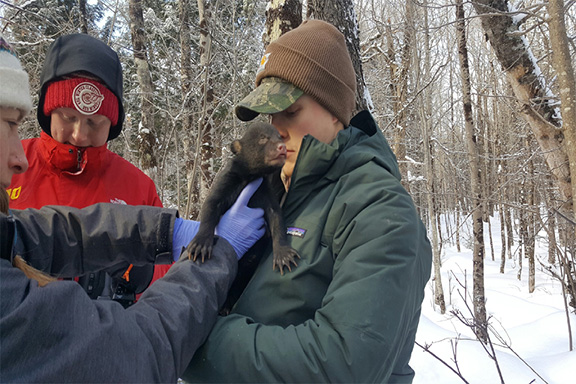
Hunting is part of the cultural fabric and history of Michigan, so it’s no surprise that the state is a stronghold for Safari Club International – with 11 chapters scattered across the upper and lower peninsulas. These chapters are a prime example of the positive impact that SCI members, along with the SCI Foundation, can have on large scale conservation efforts when they work together. These conservation efforts were recently highlighted as part of SCI’s recent Virtual World Tour in Michigan. SCIF’s Conservation Committee Chairman, Jim Hammill, was a part of the program and provided updates on the full suite of conservation programs and projects that SCI and the MIC have been involved with across the state.
The SCI Michigan Involvement Committee (MIC) was established in 1980 by chapter leadership in the state at the time. Their goal was to collaborate and leverage their resources to make a more positive impact on conservation by financially supporting projects through the Michigan Department of Natural Resources and funding research being conducted by graduate students pursuing advanced degrees in wildlife-related fields at Michigan-based universities.
40 years later the MIC has been a resounding success, and continued collaboration by the state’s SCI chapters is still an active force for conservation projects throughout the state. The MIC currently operates a sizeable annual budget thanks to voluntary contributions from chapters, matching grants from SCIF, and other donations from the public. To maximize the impact of their budget, the MIC works closely with MDNR to support projects eligible for matching federal funding from the U.S. Fish and Wildlife Service through Pittman-Robertson Act funds.

For the past decade, the Michigan Predator-Prey Project has been SCIF’s flagship project in its North American conservation program and a project that the MIC has been heavily involved with from the beginning. Since 2008, SCIF and the Hunter Legacy Endowment Fund have contributed more than $400,000 in direct grants to this research, with additional support from Michigan SCI chapters. What started initially as an effort to understand what was driving the decline of the Upper Peninsula’s deer herd turned into a decade-long project that has launched a statewide conservation movement. This multi-faceted research has resulted in dozens of peer-reviewed publications, technical reports, and academic theses and dissertations. The project has made considerable scientific contributions to wildlife management, especially white-tailed deer management in heavy snowfall areas and northern latitudes.

As part of the project, researchers with the MNDR, Mississippi State University and the SUNY College of Environmental Science and Forestry equipped female deer with transmitters capable of alerting biologists when and where that doe gave birth a fawn, which allowed researchers to fit the fawns with tracking collars as well. Data from these newborn fawns is critical to the research project as their survival is a key indicator of population trend. By tracking fawn survival and cause-specific mortality, the researchers are beginning to understand the UP’s predator-prey dynamics. Researchers also examined prey kill sites to determine the influence of bears, bobcats, coyotes, and wolves on the deer herd. This new information on predator-prey dynamics has directly influenced recommendations for predator management and hunter harvest in the region.
Data from the project showed that contrary to public perception about the impact of predators, winter severity was actually the factor that impacted the region’s deer herd the most. Heavy snowfalls force deer herds to migrate into wintering yards where they’re protected by dense thermal canopies of conifer trees. Thanks to the initial SCI/F funded research and to enhance and protect vital components of wintering habitat, the Michigan Natural Resources Commission reestablished the Upper Peninsula Habitat Workgroup (UPHWG) in 2014 to create forest management plans for deer wintering complexes. The UPHWG has since mapped out more than 50 deer wintering complexes across the Upper Peninsula and is continuing to engage with private landowners and the timber industry. Using grants from SCI Chapters the Michigan DNR, and other sources, we are now putting real habitat improvements on the ground by encouraging private landowners to manage their forests for winter deer habitat. White-tailed deer management is far from the only legacy that the MIC has created from a conservation standpoint though.

Since the MIC’s inception in 1980, the group has put together an impressive list of accomplishments including spearheading the first moose reintroduction in the Upper Peninsula in 1980’s. The MIC has provided significant funding for wildlife research and conservation projects on a multitude of game and non-game species, including moose, bears, bobcats, deer, wolves, elk, martens, snowshoe hares, feral hogs, American woodcock, ducks, and mute swans among others. The MIC has also purchased substantial amounts of equipment needed by the MDNR to conduct such projects and has been active in funding anti-poaching efforts, having provided rewards that have led directly to the arrest and conviction of several very public and egregious wildlife law violators in the past. The MIC has also been an active supporter of the MDNR leadership and the development of wildlife professionals across the state.
Michigan SCI members remain some of the most engaged and conservation minded hunters in the country, and the tangible difference the work that the MIC has accomplished should serve as model for grassroots conservation efforts across the country. SCIF will continue to remain engaged with the MIC in order to continuing leveraging resources to ensure that Michigan’s wild places and wild things remain intact for future generations to enjoy and explore.
